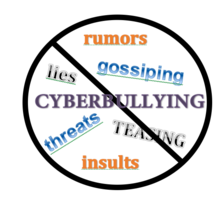User:Lilyshams23

Cyberbullying
[edit]What is cyberbullying?
[edit]- Cyberbullying is bullying with the use of digital technologies. It can take place on social media, messaging platforms, gaming platforms and mobile phones. It is repeated behaviour, aimed at scaring, angering or shaming those who are targeted. Examples include:
- spreading lies about or posting embarrassing photos or videos of someone on social media sending hurtful,abusive or threatening messages, images or videos via messaging platforms impersonating someone and sending mean messages to others on their behalf or through fake accounts.
- Face-to-face bullying and cyberbullying can often happen alongside each other. But cyberbullying leaves a digital footprint[1] – a record that can prove useful and provide evidence to help stop the abuse.
What Are the Consequences of Cyberbullying?
[edit]Sometimes, online bullying, like other kinds of bullying, can lead to serious long-lasting problems. The stress of being in a constant state of upset or fear can lead to problems with mood, energy level, sleep, and appetite. It also can make someone feel jumpy, anxious, or sad. If someone is already depressed or anxious, cyberbullying can make things much worse. Students who are cyberbullied can struggle to concentrate in school, which can affect how well they do there.
It's not just the person being bullied who gets hurt. The punishment for cyberbullies can be serious. More and more schools and after-school programs are creating systems to respond to cyberbullying. Schools may dismiss bullies from sports teams or suspend them from school. Some types of cyberbullying may violate school codes or even break anti-discrimination[2] or sexual harassment laws[3]. So a bully may face serious legal trouble.
What are the effects of cyberbullying?
[edit]When bullying happens online it can feel as if you’re being attacked everywhere, even inside your own home. It can seem like there’s no escape. The effects can last a long time and affect a person in many ways:
- Mentally – feeling upset, embarrassed, stupid, even afraid or angry.
- Emotionally – feeling ashamed or losing interest in the things you love.
- Physically – tired (loss of sleep), or experiencing symptoms like stomach aches and headaches.

cyberbullying be like :
The feeling of being laughed at or harassed by others, can prevent people from speaking up or trying to deal with the problem. In extreme cases, cyberbullying can even lead to people taking their own lives.
Cyberbullying can affect us in many ways. But these can be overcome and people can regain their confidence and health.
Frequency of Cyberbullying
[edit]
There are two sources of federally collected data on youth bullying:
The 2019 School Crime Supplement to the National Crime Victimization Survey[4] (National Center for Education Statistics and Bureau of Justice) indicates that, nationwide, about 16 percent of students in grades 9–12 experienced cyberbullying. The 2019 Youth Risk Behavior Surveillance System[5] (Centers for Disease Control and Prevention) indicates that an estimated 15.7% of high school students were electronically bullied in the 12 months prior to the survey.
[edit]According to our cyberbullying research[6], in which we studied parents of kids between the ages of 10 and 18, 21 percent of children have been cyberbullied.
[edit]for more info. visit :
https://kidshealth.org/en/teens/cyberbullying.html
https://www.stopbullying.gov/cyberbullying/what-is-it
https://www.unicef.org/end-violence/how-to-stop-cyberbullying
- ^ Associates., Learning Zone Express (Firm) Chris Jones & (2010), Digital footprint : watch where you step, Learning ZoneXpress, OCLC 688306143, retrieved 2023-01-02
- ^ "Legal Protection from Discrimination", Discrimination as Stigma : A Theory of Anti-discrimination Law, Hart Publishing, retrieved 2023-01-02
- ^ Cobb, Ellen Pinkos (2019-12-06), "Sexual harassment laws in European countries", International Workplace Sexual Harassment Laws and Developments for the Multinational Employer, Milton Park, Abingdon, Oxon; New York, NY: Routledge, 2020. |: Routledge, pp. 15–117, ISBN 978-0-429-20153-0, retrieved 2023-01-02
{{citation}}: CS1 maint: location (link) - ^ "National Crime Victimization Survey", Encyclopedia of Crime and Punishment, 2455 Teller Road, Thousand Oaks California 91320 United States: SAGE Publications, Inc., 2002, retrieved 2023-01-02
{{citation}}: no-break space character in|place=at position 18 (help)CS1 maint: location (link) - ^ Youth Risk Behavior Surveillance System - Middle School (YRBS-MS) http://dx.doi.org/10.13072/midss.362. Retrieved 2023-01-02.
{{cite web}}: Missing or empty|title=(help) - ^ "Appendix: Cyberbullying Research". Cyberbullying: 157–171. 2015-08-11. doi:10.1002/9781119221685.app1.

